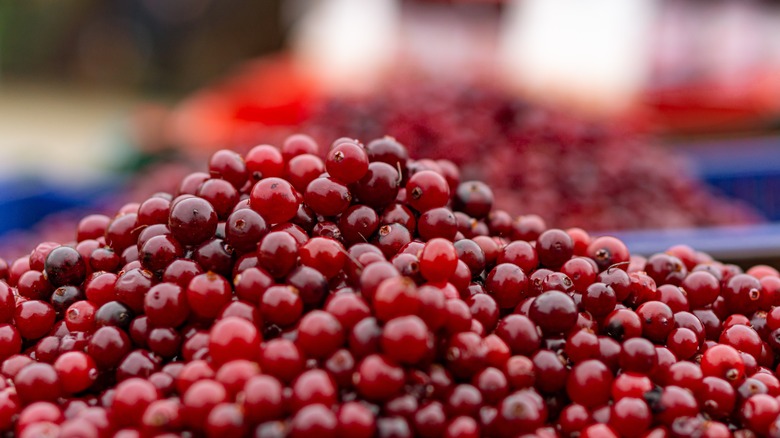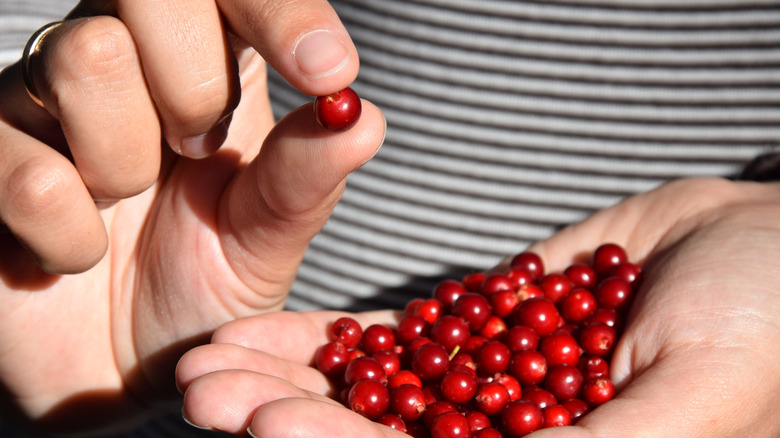The Bouncing Test That Will Help Determine The Ripeness Of Cranberries
Most of us recognize the change of seasons not only through weather updates and holidays marked on the calendar but through seasonal food offerings in grocery stores and farmers' markets. We intrinsically know cold weather is coming when we start to see supermarket entryways flooded with gourds, apples, and bright red bags of cranberries. Let's be honest: those tart berries are crucial when crafting easy cranberry sauce for holiday gatherings. However, since fresh cranberries are only able to be purchased from September through January, getting the most out of these seasonal berries when they're at their prime is essential, especially if you're someone who loves the tang and bright flavor of a ripe cranberry. But how can you truly tell your recently purchased bag of cranberries is actually fresh and ready for eating?
You may be surprised to find that the best way to test cranberries' ripeness is by dropping them onto a hard surface to see if they bounce. Cranberries naturally hold quite a bit of air, so if you want to ensure your latest bag is indeed fresh, you should be able to not only see them bounce but also hear them hitting the hard counter or surface. Yet, is this bounce test the most trusted method to gauge the ripeness of fresh cranberries? Before we talk about the shelf life of these bright, sour berries, let's discuss the history of this bounce technique and other ways to calibrate the freshness of cranberries.
The bounce test isn't just for everyday consumers
When you want to make cranberry sauce, cranberry bread, and the best cranberry recipes for the holiday season, you need fresh berries. While you may think the unique suggestion to bounce cranberries is a silly word-of-mouth technique one random foodie stumbled upon, think again. There is actually some history behind this ingenious bouncing method. In 1880, one New Jersey farmer, John "Peg Leg" Webb, had trouble carrying loads of his harvested cranberries down steep wooden steps, so one day, he decided to pour some down those steps and evaluate the process. As it turns out, the ripest berries made the furthest trek — all the way down to the bottom of the stairs, while the damaged berries hardly bounced at all. This discovery lead to the creation of the first bounce board separator that many farmers began using to test the quality of their freshly harvested cranberries. These separators are still used in harvesting facilities today; cranberries that don't bounce effectively are used for processed cranberry products like jams and jellies.
Beyond this clever bouncing technique, there are other more obvious ways to judge a cranberry's ripeness. A ripe cranberry should be slightly hard to squeeze and very rich in color. A soft cranberry that doesn't make an audible sound when dropped is a surefire sign of potential rot or damage. Now that you know the ins and outs surrounding cranberry ripeness, what is the best way to store these seasonal delicacies?
How to store fresh cranberries
Even though fresh cranberries aren't available year-round, the good news is they can be frozen quite easily for convenient use throughout the entire year. A fresh bag of cranberries will typically last at least four weeks in your refrigerator. If you've been feeling sad believing you can only enjoy your grandmother's slow-cooker cranberry-orange cake during the fall and winter seasons, you're wrong.
Fresh cranberries can actually last a full year when stored in the freezer. The best part is you don't even have to prewash these bouncing berries before sticking them into frozen storage. Simply store fresh cranberries in their original packaging. However, if you're worried about potential freezer burn, stick your bag of fresh cranberries into an additional plastic storage bag before freezing. When you're ready to use these frozen berries, all you need to do is rinse and sort out the ones that feel too soft or appear to have any visible discoloration. Then you're on your way to making all the cranberry pie you want, even if it's the middle of July. When cooking with fresh, refrigerated berries, however, give the unique bounce test a try to determine if the fresh berries you purchased are indeed ripe.


